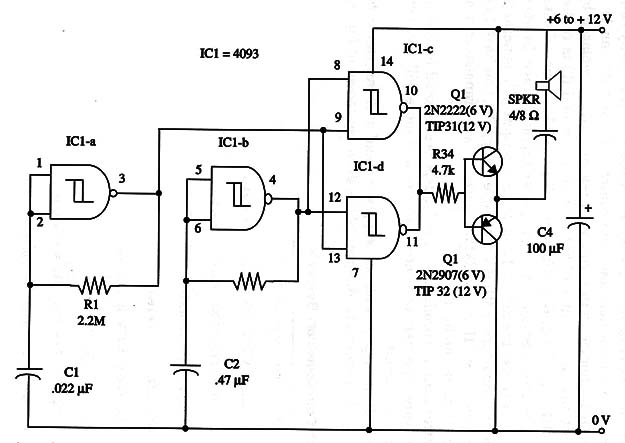The circuit doesn’t have frequency adjustments, but it easily can be altered to incorporate tone and rate controls. R1 and R2 can be replaced by potentiometers in series with resistors.
R1 is replaced by a 100 k ohm potentiometer and a 10 k ohm series resistor, and R2 is replaced by a 2.2 M ohm or a 4.7 M ohm potentiometer with a 100 k ohm series resistor.
The transistors used depend on the power supply voltage. In the 6 V version, you can use the 2N2222 and 2N2907 output pair, general purpose silicon transistors.
With 9 V (or higher) supplies, you have to use the pair formed by TIP31 and TIP32 silicon power transistors, which should be mounted on heatsinks.
For better sound reproduction, the loudspeaker should be installed in a enclosure. Speakers of 4-inch diameter and more will give better results in this circuit.
Current drain depends on the supply voltage and can range from 200 mA to 1A. A schematic diagram of the device is shown in Fig. 1.

The position of the polarized components (e.g., C3 and C4) should be
Observed.
IC1 - 4093 CMOS integrated circuit
Q1 - 2N2222 or TIP31 NPN transistor (see text)
Q2 - 2N2907 or TIP32 PNP transistor (see text)
SPKR - 4/8 ohm, 4-inch loudspeaker
R1 - 47,000 ohm, 1/4 W, 5% resistor
R2 - 2,200,000 ohm, 1/4 W, 5% resistor
R3 - 4,700 ohm, 1/4 W, 5% resistor
C1 - 0.022 11F ceramic or metal film capacitor
C2 - 0.47 µF or 1 µF metal film capacitor
C3 - 220 µF, 16 WVDC electrolytic capacitor
C4 100 µF, 16 WVDC electrolytic capacitor




